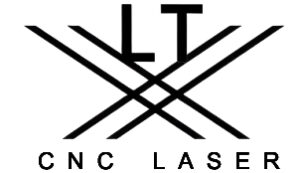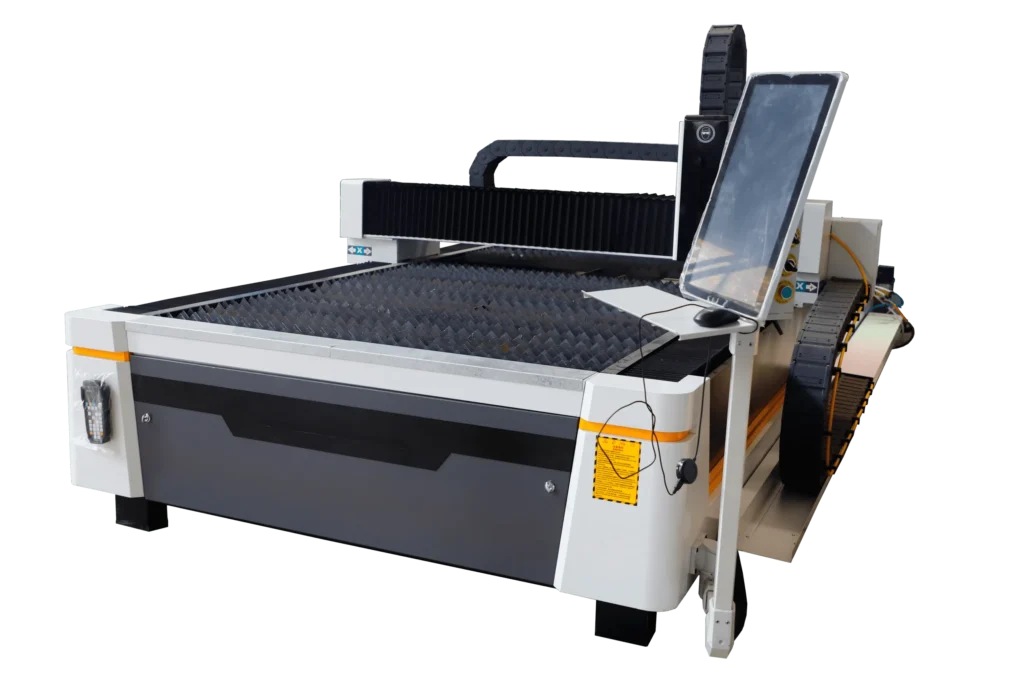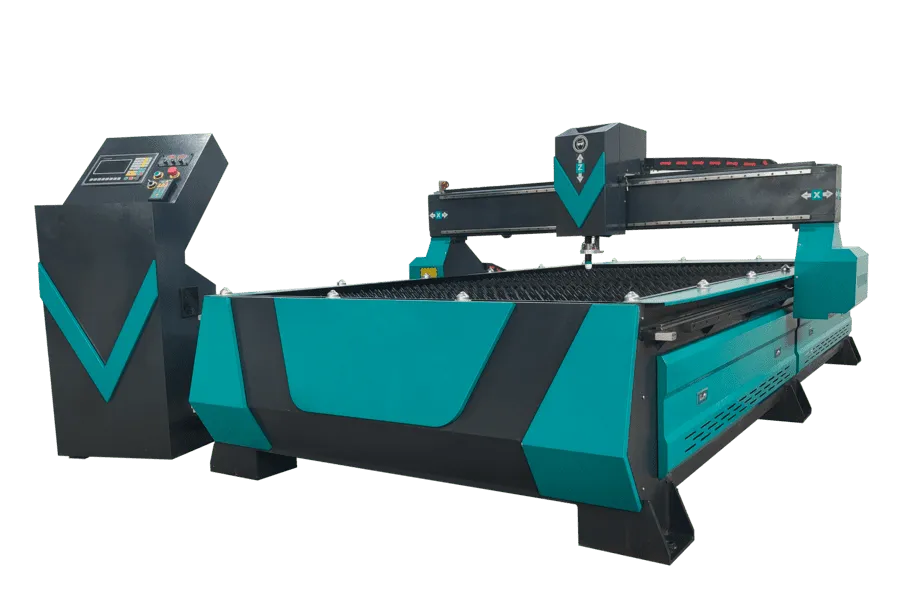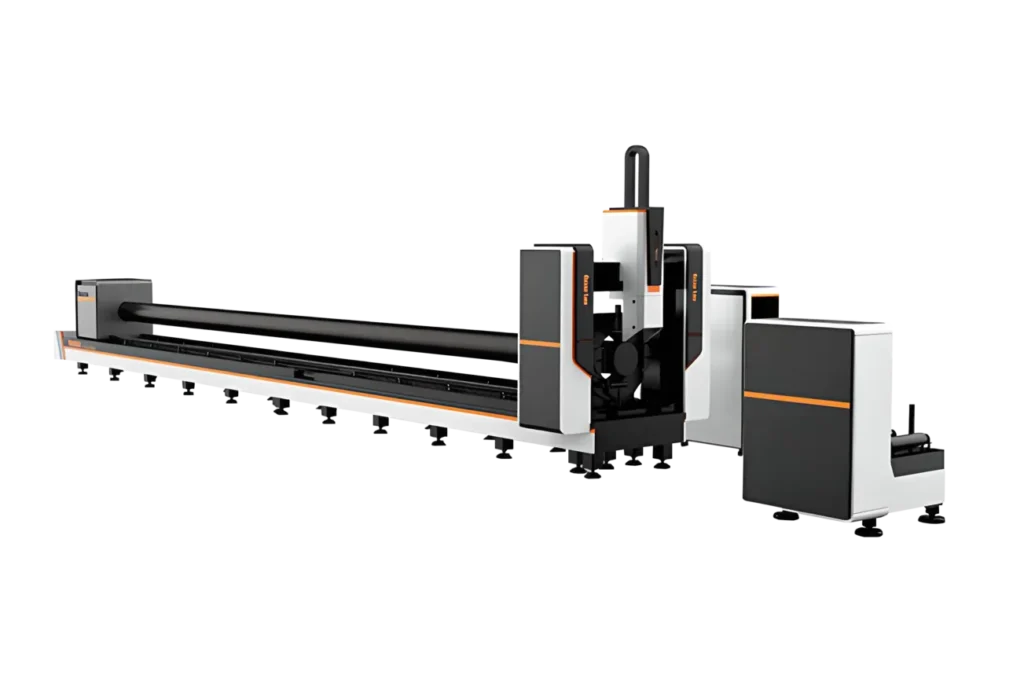In modern metal fabrication, laser cutting and various traditional cutting methods (plasma cutting, oxy-fuel flame cutting, mechanical shearing, etc.) offer distinct capabilities. Each relies on different principles, making them better suited to specific materials and thicknesses. Aluminum’s high thermal conductivity and reflectivity pose special challenges. Below, we compare the working principles, energy use and precision of each method, analyze their performance on thin, medium and thick aluminum, and review factors like cut quality, efficiency, cost and maintenance. We also examine China’s metal-cutting industry trends, export data, and leading domestic laser-cutting brands. The Chinese brand “Light CNC Laser” is profiled, and we conclude with procurement and application recommendations for end users, importers and equipment buyers.
Cutting Method Mechanisms and Characteristics
Different cutting processes remove material in fundamentally different ways:

Laser Cutting
- Laser Cutting (Fiber/CO(_2)) uses a concentrated, high-intensity light beam to melt or vaporize metal along a programmed path 1 2. Modern CNC fiber lasers (typically 1–12 kW) can focus energy with (\pm)0.01–0.05 mm precision 1 3. Because the beam is contactless, lasers produce smooth, narrow kerts with virtually no burr 4 5. This yields sharp, clean edges and requires little post-processing. Laser machines typically run on electricity (some use CO(_2) or fiber optics to deliver the beam) and consume energy more efficiently than plasma systems 6. However, high-power lasers have higher capital cost ($50k–$500k) and may struggle with very thick or highly reflective metals unless specialized (e.g. very high power or short wavelength) 7 8.
Laser cutting a steel plate – a high-power laser head melts the metal, yielding a clean cut with minimal heat spread 4 2.
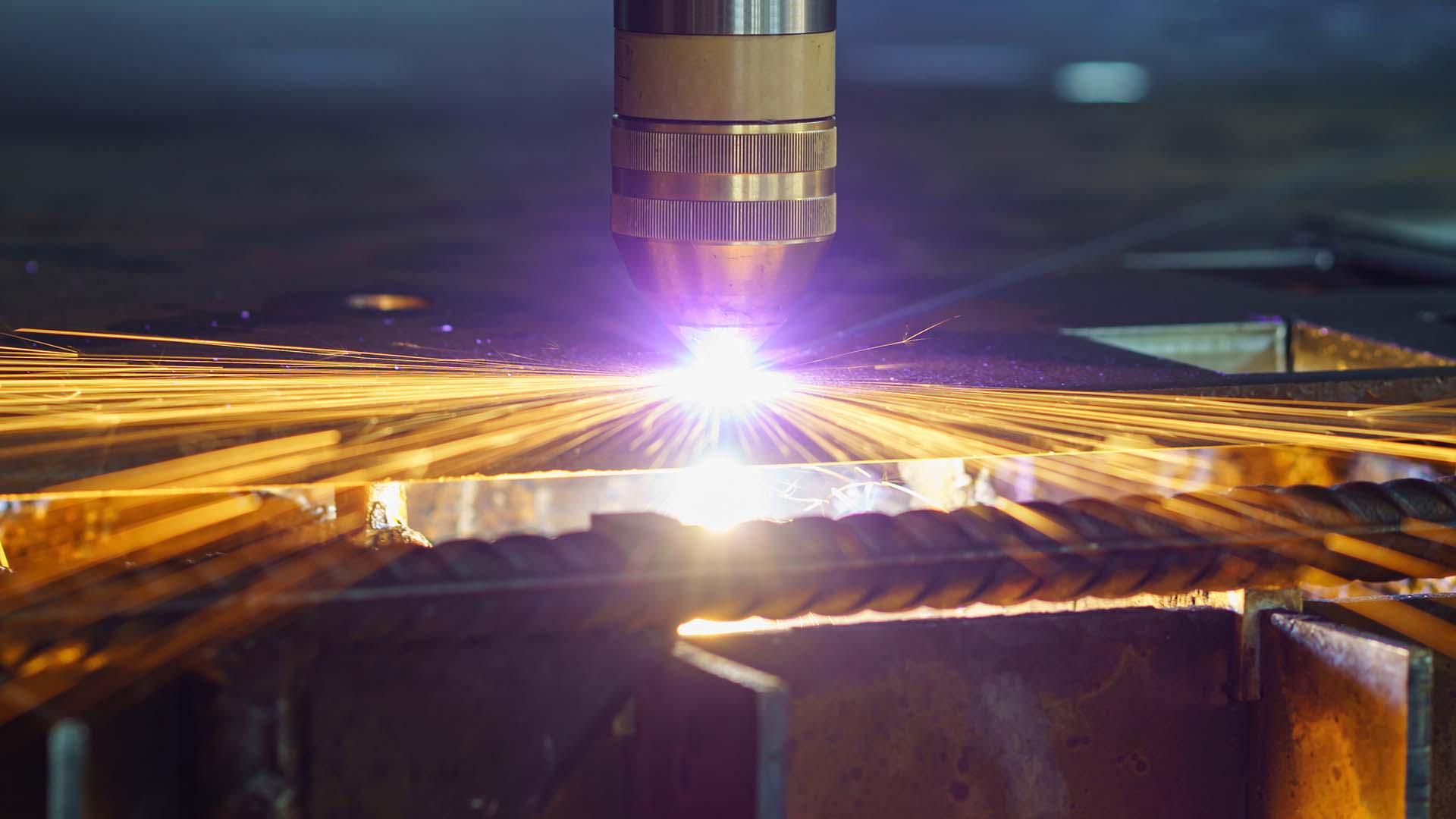
Plasma Cutting
- Plasma Cutting uses a high-temperature ionized gas arc to melt metal and blow away the molten material 9 10. A plasma torch generates an extremely hot plasma jet (18,000–23,000°C) through compressed gas or air 9. As the arc contacts the workpiece, it rapidly melts the metal; high-velocity gas clears the cut. Plasma cutters are powered by electricity and require compressed gas (often air, oxygen, or nitrogen). They are energetic and fast, especially on thick, conductive metals. Plasma easily cuts conductive materials (steel, aluminum, copper) – even those that oxy-fuel cannot handle 11 9. Because the arc is wider and hotter than a laser spot, plasma cuts have a wider kerf and rougher surface with slag or dross 4 12. Heat-Affected Zones (HAZ) are generally larger. Nonetheless, plasma excels at thick-section cutting: industrial plasma systems can cut metals (\geq)50 mm thick, beyond most commercial laser capacities 13 10. Many plasma machines are also portable and rugged for field work.
Plasma cutting on steel: an ionized gas arc melts and ejects metal. Plasma cutters are fast on thick plates but leave a coarser cut than lasers 9 4.

Flame Cutting
- Oxy-Fuel Flame Cutting (gas/acetylene flame cutting) heats the metal with a fuel-oxygen flame, then injects a high-pressure oxygen stream that combusts (oxidizes) the hot metal, blowing away the molten oxide 14 15. This process is self-sustaining on steels because steel burns readily at high temperature. However, flame cutting only works on ferrous alloys: the material must ignite and burn under oxygen. Aluminum does not burn (its oxide has a higher melting point than aluminum itself 16), so traditional oxy-fuel cannot cut aluminum cleanly 17 18. Indeed, flame cutting is generally limited to carbon/low-alloy steels and cast iron 17. Flame equipment (torches, gas cylinders) is inexpensive and portable, but produces wide kerfs and large HAZ, and yields a rough edge that usually needs grinding 17.

Machanical Blade Sawing
- Mechanical Shearing uses sharp blades (like a giant shear or scissors) to slice sheet metal. A bottom (fixed) blade and top (moving) blade clamp the metal, and the top blade descends with great force to shear the material 18. No heat is involved, so there is no HAZ or thermal distortion. Shearing produces straight cuts very rapidly, especially on stacks of thin-to-medium sheets 19. The kerf is essentially zero (almost no material is lost) 20. Modern hydraulic or mechanical shears can handle moderate aluminum plate thickness (often several millimeters). Shearing is extremely fast and cost-effective for long, straight cuts 19 21, and it works well on soft metals like aluminum, since it does not harden or distort the cut edges 22. The main drawbacks are that the cut must be a straight (or very simple) line (no intricate shapes) and sheet size is limited by machine capacity. Edges may have minor burrs or slivers 23, requiring minimal deburring.
Table: Comparison of Cutting Methods for Aluminum (typical characteristics)
| Method | Mechanism | Applicable Thickness (Al) | Edge Finish | Speed/ Efficiency | Key Advantages | Key Drawbacks |
|---|---|---|---|---|---|---|
| Laser (fiber/ CO₂) | High-power laser beam melts/ vaporizes 9 | Thin-medium (up to ~5-16 mm depending on power) | Very smooth, burr-free 4 5 | Extremely fast on thin plates 1; CNC precision | Ultrahigh precision, flexible geometry; low heat input | High equipment cost; less effective >15–20 mm; reflective metals require care 7 8 |
| Plasma | Hot plasma arc melts metal; gas blows away molten metal 9 | Medium-thick (effective >10 mm, up to ~50 mm) 13 10 | Moderately rough; wider kerf; slag/burrs 24 | Very fast on thick plates 25 | Cuts very thick and conductive materials; portable; lower capital cost | Lower precision; larger HAZ; consumables (nozzles) wear; more finish work 24 12 |
| Oxy-Fuel (Flame) | Burning steel in oxygen stream 14 | Only carbon steels (not aluminum) 17 16 | Coarse; wide kerf; significant HAZ | Slow (especially on thinner metals) | Very low equipment cost; thick steel cutting | Cannot cut aluminum cleanly; rough cut; large HAZ; less precise 17 16 |
| Shearing | Mechanical blade shearing (no heat) 18 | Thin-medium sheets (machine limit, e.g. (\leq)6–10 mm) 22 | Straight, square edges (some burr possible) | Very fast for straight cuts 19 | No heat, no HAZ; minimal kerf (no waste) 20 | Only straight cuts; limited to plate (no contours); blades wear; burrs 23 22 |
| Waterjet (Abrasive) | High-pressure water+abrasive erosive cutting (cold) | Very thick plates (no hard limit); all materials | Smooth, no thermal distortion | Moderate (slow on very thick) | No HAZ or heat distortion; cuts any material | Slow; high power/pump cost; consumables (abrasive) |
Sources: Mechanical and thermal cutting techniques 18 9 14 19.
Applicability by Aluminum Thickness
The choice of cutting method strongly depends on aluminum thickness:
-
Thin Aluminum ((\leq)3-5 mm): Fiber lasers excel on thin sheets, offering highest precision and fastest speeds 1 8. Laser-cut parts have excellent edge quality with minimal heat distortion. Plasma can cut thin aluminum but may be overkill; its kerf is larger and parts often need cleaning. Shearing is also very effective on thin coils (ideal for long straight cuts 19). Oxy-fuel is not used for aluminum. In practice, sheet metal shops typically use lasers (or even CNC presses for simple shapes) for intricate profiles, and shears for high-volume blanks. For micro or jewelry work, fiber lasers are the standard.
-
Medium-Thickness Aluminum ((\approx)5-15 mm): High-power lasers (2-6 kW fiber or high-power CO₂) can cut through medium plates (some models handle up to ~12-16 mm 8). Cuts remain very clean but require ramped-down speed. Plasma cutters become increasingly attractive in this range: industrial plasmas easily slice 6-25 mm aluminum, often faster than lasers on thicker sections 1 12. Mechanical shears (plate shears) may still handle thicker aluminum than steel (due to its softness), but most standard shears top out around 6-10 mm. Precision declines for shearing on thicker stock. Flame cutting remains inapplicable. For these thicknesses, a dual machine strategy (laser for <10 mm, plasma for >10 mm) is common.
-
Thick Aluminum ((\approx)15-20 mm): Laser cutting quickly becomes uneconomical or infeasible on very thick aluminum. Even high-end lasers (10-20 kW) struggle beyond ~20 mm – the cut would be slow and rough 13 8. Heavy-duty plasma cutters can cut aluminum in this range (some systems handle 25–50 mm) 13 10, though the cut surface will be relatively rough and warped. In practice, when true “plate” aluminum ((>)20 mm) must be cut, manufacturers often turn to waterjet cutting (no HAZ, any thickness) or machining (sawing/boring), since aluminum in this range is typically for specialized applications. Shearing can occasionally cut thick aluminum with strong blades, but only for straight cuts.
In summary, thin aluminum favors laser and shear, mid-thickness can use high-power laser or plasma, and very thick aluminum typically requires plasma/waterjet (since flame and standard shears are not options, and laser is too slow). Modern manufacturing sometimes combines two systems: e.g. a laser+plasma hybrid (laser head for precision thin cuts, plasma torch for thicker plates) to cover the full range.
Performance in Aluminum Cutting
Cut Quality and Heat Effects
-
Laser Cutting Quality: Fiber lasers produce excellent edge quality on aluminum. Cuts are smooth, with sharp edges and almost no burring or dross 4 5. The heat input is very localized, yielding a narrow Heat-Affected Zone (HAZ); warping is minimal if clamping and backing are used properly 4 26. Mirrors or lenses can be damaged by aluminum’s reflectivity, but modern lasers compensate (often using pulse modes or high-frequency beams for reflective metals). The edge is typically as-machined quality or better. Because aluminum has high thermal conductivity, the molten pool is small, but clamping or water tables are often needed to manage even slight bending in thin sheets.
-
Plasma Cutting Quality: Plasma-cut aluminum tends to have rougher edges with visible dross and striations 24. The HAZ is larger due to extreme heat spread; aluminum parts often exhibit discoloration and annealing along the cut. Plasma gouges a wider kerf, and requires heavier shielding gas (often nitrogen or air) to minimize oxidization. Compared to steel, aluminum cuts may also flood or pinch if the plasma arc is not properly tuned (aluminum’s thermal properties can cause undercut). Thus plasma-cut aluminum usually needs secondary grinding or buffing for finished parts. For thick plates, however, plasma may actually yield a smoother finish than an equivalent laser (as Hypertherm notes, plasma edges can be “smoother than with laser” on very thick sections 25).
-
Flame (Oxy-fuel) Quality: Since flame cutting is unsuitable for aluminum, its edge quality on aluminum is effectively unusable. If attempted, the aluminum will simply melt irregularly, with no cutting action, producing a mess. Flame cutting only yields acceptable edges on carbon steel, and even there the edge is coarse and requires clean-up 17.
-
Shearing Quality: Shearing yields square-cut edges. On aluminum, this is a very clean shear – no heat discoloration or metallurgical change occurs 22. The cut face is smooth and slightly radiused by the blade gap; no slag or burr is left if the blades are sharp. However, a small burr might form on the bottom side (the portion against the moving blade) when cutting thicker sheets 23. Overall, shearing is excellent at preserving aluminum’s surface integrity: there is no HAZ or softening, which is ideal for applications sensitive to metal temper (e.g. aerospace profiles). The downside is that shearing can only produce straight cuts or simple geometries; any cut edge is perfectly straight and straight-line only.
Speed and Productivity
-
Laser Cutting Speed: For thin aluminum, lasers cut extremely quickly. A small (1–2 kW) fiber laser can cut several meters per minute on 1–3 mm sheet 1. Complex nesting and small holes are cut without slowdown. However, as thickness increases, speed drops (for example, a 4 kW laser might cut ~6 m/min on 1 mm Al, but only a few m/min on 10 mm Al). Generally, lasers outperform plasma on thinner gauges 1 but lose their edge on very thick work, where the low depth of focus becomes a limiting factor. Laser motion is CNC-controlled, so no retooling is needed between jobs, enabling fast changeovers.
-
Plasma Cutting Speed: Plasma machines shine on thicker aluminum. For aluminum plate above a few millimeters, a plasma torch cuts faster than laser. Hypertherm notes that on thick metals (>16 mm) plasma can be much faster than a laser 1 12. Even on moderate thickness (5–12 mm), large plasma tables can swiftly cut parts. Speed also benefits from stack cutting: plasma can often cut multiple plates at once, further boosting throughput. On thin sheet, plasma speed is still high, but precision holes smaller than the nozzle are not possible. As thickness grows, plasma maintains cutting momentum longer than lasers, which suffer from beam scatter and need multiple passes.
-
Shearing Speed: For straight cuts, shearing is usually the fastest method of all. A hydraulic shear can cut dozens of sheets per minute, or slice a sheet in one quick stroke 19. This is far faster than any thermal cut for equivalent straight cuts. If production involves large runs of rectangular blanks or linear cuts, shearing’s throughput is unmatched. There is no warm-up or piercing time as with lasers/plasma. However, because shears only do straight cuts, any non-linear shape requires other methods.
-
Flame Cutting Speed: Flame cutting is relatively slow, especially on thinner plates. It excels only when cutting very thick carbon steel (several inches) where it may be faster than plasma. Since flame cannot be used on aluminum, this aspect is moot for aluminum work.
Cost and Maintenance
-
Laser Cutting Cost: Fiber lasers have high initial cost but low per-part cost in high-volume use. Operating costs include electricity (for laser source and cooling) and assist gas (usually nitrogen or oxygen). Maintenance involves periodic replacement of focusing optics (when ablated) and ensuring the laser source is stable. Fiber lasers have no consumable electrodes, but the diode pump modules eventually degrade. Well-maintained lasers are reliable. Because of the high speed and precision, the labor cost per part is low. However, if the volume is very low, the amortized machine cost can be high. In China, laser cutting rates are reported around $15–$20/hour 7, which is still competitive globally.
-
Plasma Cutting Cost: Plasma tables are cheaper to purchase (from ~$10k for small machines to ~$100k for large CNC tables 7). Plasma uses consumables (nozzles, electrodes) that must be replaced frequently, especially on abrasive cuts. They also use compressed air or mixed gases, which is an ongoing expense. Power consumption can be high but typically plasma stations run on standard three-phase power. Overall, operating cost per hour is usually less than laser, making plasma appealing for budgets. Downtime for consumable changes is a factor. The quality trade-off may mean extra finish work, which can add labor cost.
-
Shearing Cost: Shearing is very cost-effective for straight cuts. Shearing machines have modest capital cost compared to lasers/plasma. They require electricity/hydraulic power but no consumables (except blade sharpening). Because there is minimal waste (no kerf loss) and no secondary finishing, shearing’s per-part cost is extremely low for its use case. Maintenance is limited to hydraulic oil changes and blade upkeep. The downside is the lack of flexibility; a shear is only used for simple jobs, so in a diversified fab shop its utilization may be limited.
-
Flame Cutting Cost: Flame equipment is cheapest and uses only gas. For steel, flame is economical on very thick cuts. Since it cannot cut aluminum, it is irrelevant to aluminum processing cost.
Quality vs. Productivity Trade-Off: In general, lasers give the best finish and precision at the cost of lower throughput on thick cuts, while plasmas give faster cutting on heavy plate with rougher edges. Shears offer maximum throughput for straight cuts but zero flexibility. End-users must balance quality requirements (edge tolerance, finish) against throughput and budget when choosing.
China’s Metal-Cutting Industry and Aluminum Market
China is the world’s largest producer and exporter of metal-cutting machines, including laser cutters. In 2021, China built ~446,000 metal-cutting machines (a 5.9% increase year-on-year) 27. By late 2022, annual output exceeded 570,000 units 28. Chinese-made machines dominate consumption (32% global share) 29. Government policies have strongly supported domestic CNC development 30, resulting in rapid advancement in high-precision machine tools, especially lasers. Nevertheless, high-end CNC tools are still imported for specialized needs; China remains both a major exporter of mass-market machines and a large importer of high-end devices 31.
In laser cutters, specifically, China leads global exports. A recent CRI report notes China’s export volume of laser cutting machines rose ~47% in 2021 and ~66% in Jan–Nov 2022 (to nearly 400,000 units) 32, with export value ~US$1.52 billion for 11 months of 2022. The United States, EU countries and neighboring Asian markets (South Korea, Japan, India, Russia) are primary destinations 33. This boom reflects growing worldwide acceptance of cost-competitive Chinese laser equipment. (Note: export statistics refer to machine counts, which include low-power engraving lasers as well as industrial cutters; however, the trend is clear.)
China’s aluminum industry has also been expanding. In 2024, China’s GDP growth drivers (EVs, solar, aerospace) propelled demand for aluminum panels, profiles, foils and specialty alloys 34 35. China exported ~5.83 million tons of aluminum (in various forms) in Jan–Nov 2024, up 20.8% YoY 36. High-end aluminum (aerospace grades for aircraft, rockets, military) is a particular focus – domestic firms like Dong Qing and Nanshan are supplying parts for aircraft and spacecraft 35. Overall, the aluminum fabrication sector seeks higher precision and automation. Laser cutting fits well here (for example, EV battery components, aerospace panels, etc.), creating a strong domestic market for advanced cutting tools.
Domestic laser cutting technology has matured rapidly. Chinese manufacturers (such as Han’s Laser, Bodor, HSG, G.Weike, Raycus, etc.) now produce world-class fiber lasers and systems. Top brands like Bodor and Han’s offer machines competitive with European/Japanese models in performance 37 38. Laser sources (Raycus, IPG, MAX) and components (Schneider, Yaskawa, etc.) from China’s supply chain enable lower prices 38 without sacrificing reliability. Chinese industry reports emphasize smart manufacturing and R&D: precision CNC machines and even AI-enabled systems are being introduced.
Representative Chinese laser cutter brands include:
- Han’s Laser (Han’s Group) – A major Shenzhen-based conglomerate. Offers a full range of fiber and CO₂ lasers.
- Bodor Laser (Jinan Bodor) – Leading exporter of industrial lasers (fiber and hybrid systems) with 1–24 kW powers 39
- GW Laser / Golden Laser (Wuhan) – Large producer of high-power fiber lasers (up to ~100 kW).
- HSG Laser (Nantong) – Known for high-quality lasers and international certification.
- JPT (Jiangsu) – Produces fiber laser sources integrated into OEM machines.
- Light CNC Laser (Jinan) – Focus of our profile below.
These and other firms regularly exhibit at international trade shows and establish overseas subsidiaries, reflecting China’s strategy to capture global market share.
Spotlight: Light CNC Laser (Chinese Brand Overview)

Light CNC Laser
Light CNC Laser (Jinan Light CNC Laser Equipment Co., Ltd.) is a Chinese manufacturer specializing in CNC fiber laser cutters, plasma cutters, and tube/pipe cutting machines 40. In operation for over 15 years, Light CNC offers various models for sheet and tube cutting, integrating components from reputable suppliers (e.g. Raytools laser heads, Yaskawa or Leadshine servos, Schneider electrics 41 38). Their fiber lasers range from 1 kW to 60 kW 42, covering entry-level to industrial needs, and they also produce multi-function machines (laser + plasma heads) 43.
Light CNC emphasizes versatility and suitability for aluminum and other metals. Their laser systems are designed “for cutting materials like stainless steel, carbon steel, aluminum” with high precision 37. On their dual-system models, Light CNC specifies that the laser head specializes on thin materials ((\leq)20 mm), while the plasma torch handles thicker or reflective metals (copper, aluminum, galvanized steel) 43. For example, a model LT3015-FS can be equipped with a 1–6 kW fiber laser (for (\leq)20 mm) plus a 100–200 A plasma source (for >20 mm) 43 44. This allows customers to use one machine for both fine (laser) and heavy-duty (plasma) cuts.
In terms of performance, Light CNC machines are reported to achieve ±0.03–0.05 mm positioning accuracy 45, with cutting speeds up to ~100 m/min (depending on power) and support both oxygen and nitrogen as assist gases 46. Their frames and tables are built heavy-duty (aluminum profiles, welded steel) to maintain rigidity. A helpful feature is their emphasis on quality control: Light CNC’s own data claims that they export 60+ models to over 90 countries, with ~2,600 machines shipped worldwide 47. They also highlight partnerships with top component brands (Yaskawa, IPG, MAX, Raycus, Schneider, Raytools, etc.) to ensure stability 38.
For aluminum cutting specifically, Light CNC’s advantages include:
- Fiber laser source (good for reflective metals like aluminum when using nitrogen assist) 37
- Fully enclosed cutting tables (for fume control and safety)
- Precise motion control (CNC controls like FSCUT or Weihong)
- Vacuum or blade tables that hold thin aluminum in place without warping
As evidence of market acceptance, Light CNC states it has over 1,400 global customers in 90+ countries 47. This indicates some level of trust among importers (though exact overseas performance data is proprietary). In practical use, Light CNC machines have reportedly been used in metal fabrication shops worldwide, particularly in emerging markets where cost is a factor. They compete by offering customizable machines (plasma-only, laser-only, or combined), and their website showcases projects in advertising, furniture, automotive, and construction, including steel structures and bridges 40.
In summary, Light CNC Laser exemplifies the new generation of Chinese cutting equipment: comprehensive product lines, international components, and aggressive export expansion. Their dual laser-plasma models are especially well-suited for mixed aluminum/steel shops. However, as with any brand, buyers should verify local support and training when importing such machinery.
Procurement and Application Recommendations
Based on the above analysis, the following guidelines can help end-users, foreign buyers, and brand decision-makers choose and apply aluminum cutting solutions:
-
Match Method to Job Profile: For primarily thin aluminum sheetwork, fiber laser cutters are generally the best choice. They offer unbeatable precision and speed for up to ~10 mm thickness 8. For larger, simple parts (straight cuts), a mechanical shear can supplement lasers to save cost on volume production 19. For thicker aluminum (above ~10–15 mm), consider plasma cutting or waterjet. Plasma is faster and less expensive for thicknesses up to ~50 mm 48, though be prepared for rougher edges. Waterjet (not thermal) can cut any thickness without HAZ, but is slower and costlier to operate. Oxy-fuel cutting is not recommended for aluminum at all.
-
Consider Total Cost: Factor in not just machine price but operating costs and labor. Laser machines cost more upfront but may reduce labor and rework; plasma machines cost less but need consumables and more finishing work. For example, Chinese lasers might run ~$15–20/hour 7, whereas plasma may be cheaper per hour. Evaluate the scale of production: small shops with light usage might favor a lower-cost plasma or used machine, while high-volume shops may justify the laser cost.
-
Evaluate Machine Specs: When buying a laser cutter for aluminum, ensure it has adequate power and features: fiber lasers (not CO(_2)) are preferred for aluminum; check the maximum cutting thickness (see [54]); inquire about aluminum-specific modules (e.g. two-stage ignition for better piercing). If buying a plasma cutter, verify amperage (higher amps = thicker cut) and gas capabilities (plasma cutters often use air or nitrogen for aluminum, since oxygen can oxidize the cut). For shears, ensure blade hardness is suitable for aluminum and check maximum sheet thickness capacity.
-
Certifications and Support: Importers should verify that machines meet necessary safety/quality standards in their country (CE, FCC, etc.). Choose suppliers with export experience: they should offer documentation for customs and have provision for technical support or spare parts abroad 49 50. The “Importing Fiber Laser” guide notes Chinese machines are 30–50% cheaper than Western brands with similar quality 49, but success depends on good communication and after-sales service. Consider attending industry expos or contacting distributors to see machines in action and check customer references.
-
Brand and Warranty: Among Chinese brands, reputed names like Light CNC Laser, Han’s, Bodor, HSG, etc. have established global networks. These companies often provide multiyear warranties and training, but always read the fine print. If considering a newer or less-known brand, insist on factory acceptance test videos or even a trial if possible. Ensure the contract covers spare parts delivery times. Note that even within “Made in China”, machine quality can vary; look for reviews or case studies.
-
Operational Training: Aluminum cutting, especially laser, requires correct setup (gas pressures, focus, speed parameters). Even the best machine needs skilled operators. Plan for training on cutting parameters for aluminum: for example, pure nitrogen assist is usually needed to avoid oxide formation 51. Thicker cuts may benefit from techniques like kerf offset or special nozzles. Maintenance skills are important too (e.g. changing laser focusing lens, plasma consumables).
-
Workflow Integration: For complex jobs, a hybrid setup might be ideal: use a laser for nested flat parts (battery connectors, brackets, trim) and a plasma/waterjet for frames or structural components. Automating material handling (loading tables, conveyors) can further boost efficiency. Also consider downstream processes: if welding is planned, remember that laser-cut aluminum may have an oxide layer that welders remove; some shops lightly clean edges or mill them post-cutting.
-
Domestic vs. Local Purchase: In China or regions well served by Chinese equipment, consider local assembly plants or dealers for faster support. For foreign buyers far from China, weigh the cost savings against potential difficulties in shipping large machines and the learning curve. Some Chinese vendors partner with local firms for service. Always clarify warranty terms (e.g. whether travel expenses for service techs are included).
-
Brandowners/Marketing: For OEMs or fabricators branding their products, investing in laser cutting can be a selling point (clean edges, custom shapes). China’s aluminum parts exporters often tout “laser-cut precision” as a quality feature. End-users importing custom cut aluminum components should specify tolerances achievable by laser to avoid surprises (lasers can hit ~0.1 mm accuracy, which shears/waterjets cannot).
Summary
Laser cutting and traditional methods each have advantages in aluminum fabrication. Laser cutting offers unmatched precision and clean edges for thin-to-moderate aluminum, while plasma cutting excels on very thick sections and conductive metals, albeit with rougher edges 4 10. Shearing remains invaluable for straight cuts on sheet metal (especially high volume) 19. Flame cutting is ineffective on aluminum 17 16. When deciding, consider thickness, required edge quality, speed, and budget.
The Chinese machine-tool industry is rapidly advancing, with laser cutters now a major export product 32 27. Domestic brands like Light CNC Laser provide a wide range of equipment tailored for aluminum and other metals 37 43. These machines use international components and serve hundreds of overseas clients 47. Global buyers should leverage China’s competitive pricing and innovation, but also perform due diligence on product support and certification 49 50.
Recommendation: For a modern aluminum fabrication line, we suggest a mix of cutting technologies. Equip for fiber laser cutting to handle detailed thin/medium work (automotive panels, furniture parts, enclosures), and maintain plasma or waterjet capabilities for any very thick plate or heavy fabrication. Add a shear for straight-line cutting of sheet stock. When procuring, prioritize machines from established brands (e.g. Light CNC Laser, Bodor, Han’s, etc.) with proven track records. Ensure adequate cooling/extraction (especially for aluminum’s fumes) and operator training. In short, use lasers for precision where it counts, and deploy traditional methods only where laser cannot economically penetrate. This hybrid approach will yield the best combination of quality, efficiency and cost-effectiveness in aluminum processing.
Sources: Cutting method comparisons and data 1 24 8 19; Chinese industry and export trends 32 27 36; Light CNC Laser product info and corporate data 40 43 47; Importer guidelines 49 50.
1 4 6 7 13 24 48 Laser Cutting vs Plasma Cutting: A Detailed Guide | RapidDirect https://www.rapiddirect.com/blog/laser-cutting-vs-plasma-cutting/
2 3 5 8 26 Everything You Need To Know Laser Cutting Aluminum for Metal
https://dplaser.com/laser-cutting-aluminum-for-metal-ultimate-guide/
9 Versatile Plasma Cutting Machines for All Metal Cutting Needs
https://lightcnclaser.com/plasma-cutting-machine/
10 12 25 Plasma Cutting Remains a Metal Industry Powerhouse
https://www.hypertherm.com/en-US/resources/more-resources/blogs/plasma-metal-industry-powerhouse/
11 Comparison of traditional cutting technology and laser cutting technology
https://www.oreelaser.com/blog/Comparison-of-traditional-cutting-technology-and-laser-cutting-technology-315.html
14 17 The Difference Between Flame Cutting, Plasma Cutting and Waterjet Cutting | Metal Supermarkets UK
https://www.metalsupermarkets.co.uk/difference-flame-cutting-plasma-cutting-waterjet-cutting/
15 16 Cutting Aluminum with Oxy/Act...
https://app.aws.org/forum/topic_show.pl?tid=16448
18 19 20 21 22 23 What Is Metal Shearing And How Does It Compare To Other Methods?
https://www.gauermetal.com/what-is-metal-shearing-and-how-does-it-compare-to-other-methods/
27 28 29 30 31 China's Machine Tool Industry: Market Trends and Opportunities
https://www.china-briefing.com/news/chinas-machine-tool-industry-market-trends-and-opportunities/
32 33 China's Laser Cutting Machine Export Data & Analysis 2023-2032
https://www.cri-report.com/chinas-laser-cutting-machine-export/?srstltid=AfmBOogGzzSzs93uDUMhZChZDMxqxml5WOMwBefsi2Tdx_7pwfIOkM-4
34 35 36 Major Events in China's Aluminum Industry in 2024 - Huaxiao Metal
https://www.huaxiaometal.com/news/industry-news/major-events-in-chinas-aluminum-industry-in-2024.html
37 42 51 High-Performance Fiber Laser Cutting Machines for Versatile Applications
https://lightcnclaser.com/fiber-laser-cutting-machine/
38 40 47 Chinese Metal Laser and Plasma Cutter Supplier
https://lightcnclaser.com/
39 Bodor Laser Leads the Way in Global Machine Tool Industry
https://www.bodor.com/en/news/company/Bodor-2024-in-Review.html
41 43 44 45 46 High-Performance CNC Plasma Laser Cutter | Dual-System Metal Cutting Machine - Metal Cutting Machine Supplier
https://lightcnclaser.com/high-performance-cnc-plasma-laser-cutter-dual-system-metal-cutting-machine/
49 50 Importing a Fiber Laser Cutter: U.S. Buyer’s Guide | Senfeng USA
https://www.senfenglaserusa.com/news/importing-a-fiber-laser-cutter-us-buyers-guide/?srstltid=AfmBOogusqV29qORjhGTPKshizrVO3QZbGTIUXIceGSH5jYhLcvRh4qV
